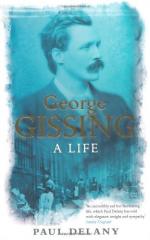|
This section contains 1,558 words (approx. 6 pages at 300 words per page) |

|
SOURCE: “Gissing's Allegorical ‘House of Cobwebs,’” in Studies in Short Fiction, Vol. VII, No. 2, Spring, 1970, pp. 324-26.
In the following essay, Adams deems Gissing's short story “The House of Cobwebs” as an allegory depicting the fate of the artist in society.
Literary critics class George Gissing most frequently with the realistic-naturalistic writers of the late nineteenth century. However, as Wendell V. Harris has noted in “An Approach to Gissing's Short Stories,” Gissing's stories lack “the omnipresent greyness and bitterness of tone” usually attributed to late nineteenth-century realistic fiction and contain instead warmth of tone, humorous touches, and subtle character portraiture.1 These characteristics are especially notable in Gissing's short story “The House of Cobwebs,” which Mr. Harris finds typical of Gissing's best work. The story is, in fact, even further removed from the characteristics usually associated with realistic-naturalistic fiction in its being an allegory depicting the fate of the...
|
This section contains 1,558 words (approx. 6 pages at 300 words per page) |

|


